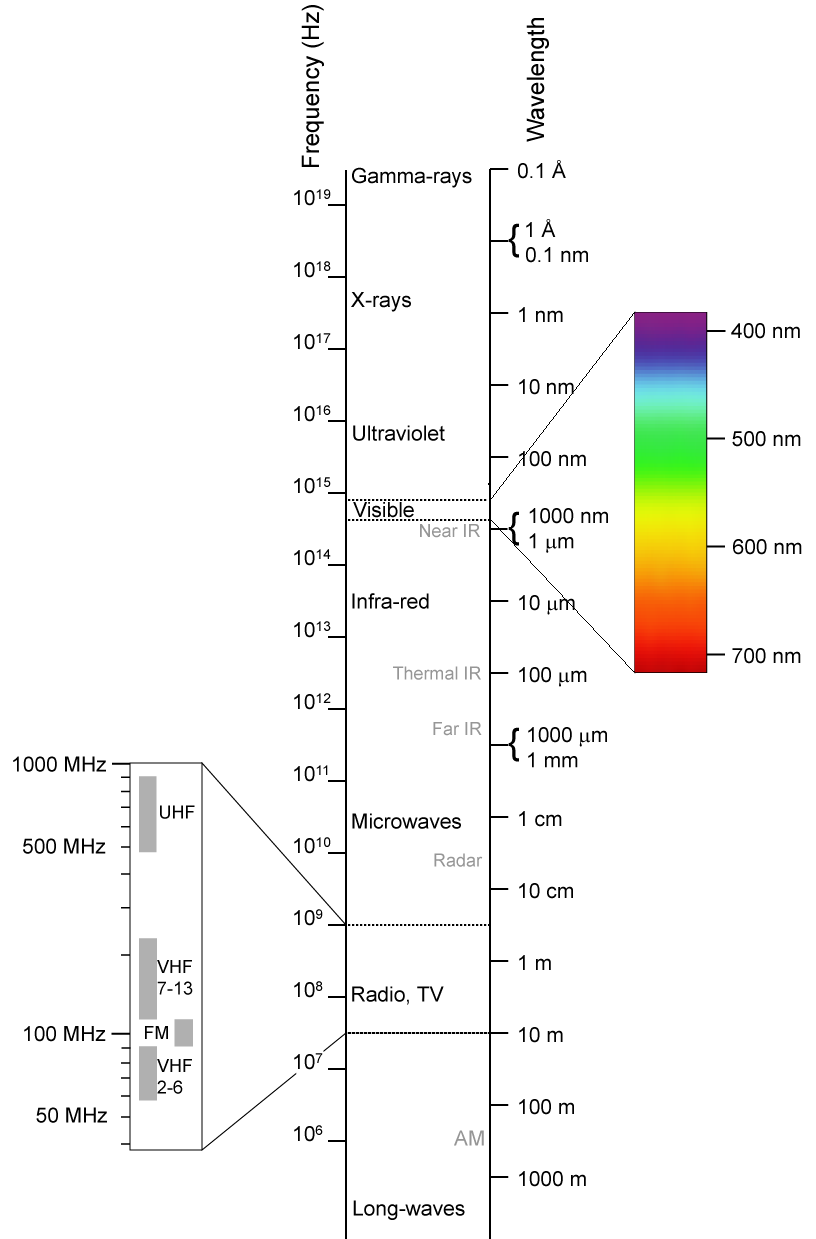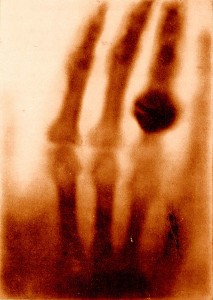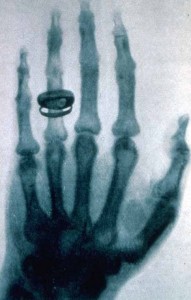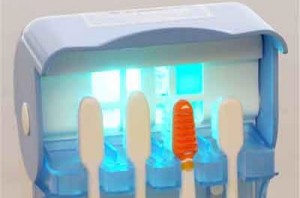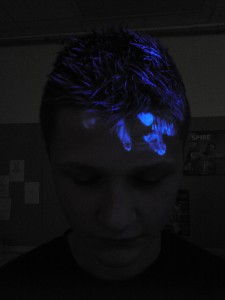Use these materials to help you prepare for the assessment at the start of next week. Studying up to page 7 of the attached file will cover the topics in the test.
 mrmackenzie
mrmackenzie
National 5 – Work
Here is a short summary of the Work topic from the Dynamics and Space unit.
National 5 – Forces
We’ve been learning about forces over the past two weeks. Here are some summary notes to help you with the key points of this topic.
Using Excel in AH Physics
You will need the attached file when we go to the library to learn about using Excel to crunch data for your project.
capacitors
You recently completed the topic on capacitors in dc circuits, finishing off with a detailed study of the graphs obtained for current & voltage against time when a capacitor is charged or discharged through a series resistor. There are some additional notes and practice questions at the end of this post but please watch the embedded video clips first.
This introduction to capacitors from the nice people at Make Magazine is a good starting point.
The S-cool revision site has some helpful notes and illustrations on capacitor behaviour; try page 1 (how capacitors work) and page 2 (charging and discharging).
There is information on charging and discharging capacitors on BBC Bitesize.
Use your knowledge of capacitor behaviour to explain how a flashing neon bulb can be controlled using a capacitor & resistor arranged in series. Here is a short video introduction to help with that.
Blinking Neon Bulb (5F30.60A) from Ricardo Alarcon on Vimeo.
There are people working to replace heavy battery packs with modern, high capacitance devices called supercapacitors. These supercapacitors have superior energy storage compared to the normal electrolytic capacitors you will have used in class. This video goes one step further and shows the fun you could have with an ultracapacitor. Do not try this at home!
Of course, you can always make your own capacitor with paper and electrically conductive paint.
Finally, you looked at capacitors in ac circuits. You need to know that a capacitor will allow an ac current to flow. The current in such a circuit will increase as the current increases. Mr Mallon’s site has a revision activity about capacitors in ac circuits.
Now download the pdf below. It contains notes to help with your prelim revision and some extra capacitor problems.
Thanks to Fife Science for the original pdf from Martin Cunningham.
waves & radiation revision notes
The unit assessment for the Waves & Radiation unit of National 5 is scheduled for next week. These notes will be useful as you prepare for the test.
Thanks to Mr Noble for sharing these notes.
internal resistance
Last week, we learned about internal resistance of cells. Page 24 of your printed notes explains how to use a simple series circuit containing a cell, resistance box, ammeter and voltmeter to determine the internal resistance of the cell. By plotting a graph of your dat, with current on the x-axis and voltage on the y-axis, you can find the internal resistance of the cell.
The video below shows the same type of experiment, but uses a potato and two different metals in place of a normal cell. Watch the video and note the values of I and V each time the resistance is changed – remember to pause the video each time so you can write the results. Just scroll back if you miss any.
Now plot a graph with current along the x-axis and TPD along the y-axis. If you don’t have any sheets of graph paper handy, there is a sheet available to download using the button at the end of this post. Alternatively, print a sheet from a graph paper site or use google sheetsto plot your results.
Draw a best-fit straight line for the points on your graph and find the gradient of the line. When calculating gradient, remember to convert the current units from microamps (uA) to amps (A).
The gradient of your straight line will be a negative number. The gradient is equal to -r, where r is the internal resistance of the potato cell used in the video.
You can obtain other important information from this graph;
- Extend your best fit line so that it touches the y-axis. The value of the TPD where the line touches the y-axis is equal to the EMF of the cell. (Explanation: on the y-axis, I is zero so TPD = EMF)
- Now extend the best-fit line so that it touches the x-axis, the current at that point is the short-circuit current – this is the maximum current that the potato cell can provide when the variable resistor is removed from the circuit altogether and replaced with just a wire.
x-ray radiation
X-rays are a form of electromagnetic radiation. They have a much higher frequency than visible light or ultraviolet. The diagram below, taken from Wikipedia, shows where x-rays sit in the electromagnetic spectrum.
image by Materialscientist
Wilhelm Röntgen discovered x-rays and the image below is the first x-ray image ever taken. It shows Mrs. Röntgen’s hand and wedding ring. The x-ray source used by Röntgen was quite weak, so his wife had to hold her hand still for about 15 minutes to expose the film. Can you imagine waiting that long nowadays?
This was the first time anyone had seen inside a human body without cutting it open. Poor Mrs. Röntgen was so alarmed by the sight of the image made by her husband that she cried out “I have seen my death!” Or, since she was in Germany, it might have been
“Ich habe meinen Tod gesehen!“
that she actually said.
Röntgen continued to work on x-rays until he was able to produce better images. The x-ray below was taken about a year after the first x-ray and you can see the improvements in quality.
Notice that these early x-rays are the opposite of what we would expect to see today. They show dark bones on a lighter background while we are used to seeing white bones on a dark background, such as the x-ray shown below. The difference is due to the processing the film has received after being exposed to x-rays.
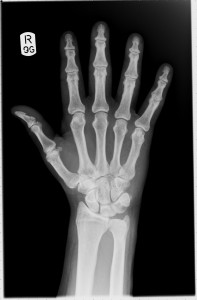 In hospitals, x-rays expose a film which is then developed and viewed with bright light. X-rays are able to travel through soft body tissue and the film behind receives a large exposure. The x-rays darken the film. More dense structures such as bone, metal fillings in teeth, artificial hip/knee joints, etc. block the path of x-rays and prevent them from reaching the film. Unexposed regions of the film remain light in colour.
In hospitals, x-rays expose a film which is then developed and viewed with bright light. X-rays are able to travel through soft body tissue and the film behind receives a large exposure. The x-rays darken the film. More dense structures such as bone, metal fillings in teeth, artificial hip/knee joints, etc. block the path of x-rays and prevent them from reaching the film. Unexposed regions of the film remain light in colour.
Röntgen’s x-ray films would have involved additional processing steps. The exposed films were developed and used to create a positive. In creating a positive, light areas become dark and dark areas become light. So the light and dark areas in Röntgen’s x-rays are the opposite of what we see today. Our modern method makes it easier to detect issues in the bones as they are the lighter areas.
Röntgen was awarded the first ever Nobel Prize for Physics in 1901 for his pioneering work in this field of physics.
I have attached a recording of a short BBC radio programme about the first x-ray and what people in the Victorian era thought of these new images. Click on the player at the end of this post or listen to it in iTunes.
ultraviolet radiation
Earlier this week, we looked at the electromagnetic spectrum, including ultraviolet radiation.
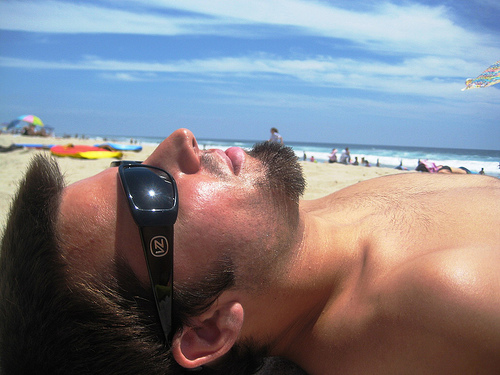
image courtesy of sonrisaelectrica
The section of the electromagnetic spectrum with wavelengths ranging from 10nm to 400nm is called ultraviolet radiation (uv for short). Sunlight contains uv rays and it’s those uv rays that are responsible for the suntan you get during the summer holidays. This Australian animation shows how the ultraviolet in sunlight causes our skin to tan and explains why too much uv will damage our skin. The SunSmart page has loads of information on staying safe in the sun.
The damage that uv can do to cells is put to good use in some sterilisation equipment, such as this bottle for safe drinking water and the toothbrush sanitiser shown below.
The Nobel Prize for Medicine was awarded to Niels Rydberg Finsen in 1903 for his research into the effects of ultraviolet on the bacteria that cause tuberculosis.
British banknotes have security features built into them. These features are only visible under uv. This image of a Clydesdale Bank £10 note shows part of the pattern that can only be seen under uv light.
 image from Science Photo Library
image from Science Photo Library
There is a Bank of England leaflet (pdf) with further information on the security features in our banknotes.
Remember that whenever something glows under a uv light, we’re not seeing the uv radiation itself because our eyes can’t detect ultraviolet. Instead, we see the fluoresence; visible light given out in response to the uv falling on the material.
Some hair gels fluoresce under uv light. Here is someone with some of the uv gel in his hair.
but we don’t see anything until we turn on the uv light.
Cool, eh?
You can even buy genetically modified tropical fish that glow under uv light.



